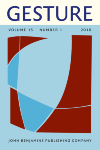
Gesture
Scope & Guideline
Exploring the nuances of non-verbal communication.
Introduction
Aims and Scopes
- Gesture and Language Development:
The journal explores how gestures contribute to language acquisition and development, particularly in children and bilingual contexts. - Multimodal Communication:
Research focuses on the interplay between verbal and non-verbal communication, examining how gestures complement or interfere with speech. - Cultural and Social Contexts of Gesture:
Studies investigate how gestures vary across cultures and social contexts, highlighting their role in politeness, interaction, and meaning-making. - Cognitive Aspects of Gesture:
The journal publishes research on the cognitive underpinnings of gesture use, including how gestures aid memory, learning, and comprehension. - Gestures in Non-Human Communication:
Research includes comparative studies on gesture use in non-human species, such as primates, providing insights into the evolutionary aspects of gesturing. - Technological and Methodological Innovations:
The journal often features studies utilizing new technologies for gesture analysis, contributing to methodological advancements in the field.
Trending and Emerging
- Impact of Gesture on Language Learning:
Recent studies explore how gestures can enhance foreign language acquisition, indicating an increasing interest in educational applications of gesture research. - Social Contexts and Gesture Modification:
There is a growing focus on how social contexts influence gesture use, particularly in multilingual settings and amongst diverse populations. - Interdisciplinary Approaches to Gesture Study:
Research increasingly integrates methodologies from various disciplines, including cognitive science and anthropology, to provide a more holistic understanding of gesture. - Gesture as a Tool for Communication in Non-Human Species:
Emerging studies on the use of gestures in non-human animals suggest a trend towards understanding the evolutionary significance of gesturing. - Technological Advances in Gesture Analysis:
The application of new technologies, such as automatic annotation tools, is trending, enabling more precise and innovative analyses of gesture in communication.
Declining or Waning
- Focus on Gesture in Specific Language Contexts:
There has been a noticeable decrease in studies focusing exclusively on gesture usage in narrow language contexts, as interdisciplinary approaches become more prevalent. - Static Representational Gestures:
Research on static gestures that convey fixed meanings seems to be waning, with a shift towards dynamic and contextualized gesture studies. - Repetitive Gesture Analysis:
The frequency of papers analyzing repetitive gestures or gestures as standalone elements has diminished, as the focus moves towards their integrative role in communication. - Historical Perspectives on Gesture:
Fewer studies are being published that analyze historical or traditional gestures, suggesting a move towards contemporary and real-time gesture analysis.
Similar Journals
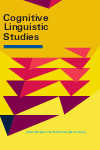
Cognitive Linguistic Studies
Illuminating the Nexus of Language, Thought, and ContextCognitive Linguistic Studies is a prestigious journal published by JOHN BENJAMINS PUBLISHING CO, dedicated to advancing the interdisciplinary field of cognitive linguistics. With an ISSN of 2213-8722 and an E-ISSN of 2213-8730, the journal serves as an essential platform for the dissemination of high-quality research that delves into the intricate relationships between language, thought, and cultural contexts. Located in the vibrant academic milieu of the Netherlands, this journal has gained recognition for its impactful contributions, reflected in its respectable Q2 category ranking within the field of Linguistics and Language as of 2023. Redesigned to accommodate a broader audience, the journal welcomes original research articles, reviews, and theoretical discussions that bridge cognitive science and linguistic inquiry. As the journal continues its trajectory of growth, being indexed with a solid Scopus rank of #459 out of 1167 in the social sciences, it remains a vital resource for researchers, professionals, and students eager to explore the dynamic interplay between cognition and language.
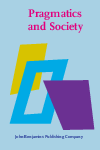
Pragmatics and Society
Connecting Linguistic Insights with Social PracticesPragmatics and Society, published by John Benjamins Publishing Co, is an esteemed journal that serves as a vital platform for the interdisciplinary exploration of language use in social contexts. Established with the aim of bridging the gap between pragmatics and social theory, this journal covers innovative research and critical methodologies within linguistics and language studies. With an impressive impact factor and recognition as a Q2 journal in the field of Linguistics and Language for 2023, it ranks notably within the 75th percentile for Arts and Humanities and 73rd for Social Sciences. Based in the Netherlands, Pragmatics and Society is dedicated to fostering scholarly discussions and advancing knowledge in areas such as discourse analysis, sociolinguistics, and communicative practices. Researchers, professionals, and students alike will find this journal to be an invaluable resource for understanding the complexities of language in society and are encouraged to engage with its rigorous publications.
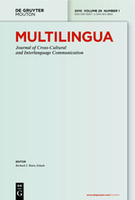
Multilingua-Journal of Cross-Cultural and Interlanguage Communication
Connecting Scholars in the Realm of MultilingualismMultilingua: Journal of Cross-Cultural and Interlanguage Communication is a premier academic journal published by DE GRUYTER MOUTON, specializing in the dynamic fields of communication and linguistics. Established in 1982, this journal has significantly contributed to the discourse surrounding multilingualism, intercultural interactions, and language acquisition, with a notable reputation backed by an impressive Q1 ranking in both Communication and Linguistics and Language for 2023. Positioned strategically at the heart of Germany, the journal serves as a vital platform for researchers, professionals, and students alike, fostering scholarly exchange and insights into cross-cultural communication practices. With rankings placing it in the top percentiles across key categories in Scopus, including Arts and Humanities and Social Sciences, Multilingua exemplifies the highest standards of academic excellence. Although currently not an Open Access journal, it continues to provide a wealth of knowledge to the global research community.

Studii de Lingvistica
Connecting scholars through groundbreaking research.Studii de Lingvistica is a premier open-access journal committed to advancing the field of linguistics and language studies since its inception in 2011. Published by EDITURA UNIV ORADEA in Romania, this scholarly platform aims to disseminate high-quality research that encompasses various aspects of linguistics, encouraging contributions from researchers and professionals worldwide. With an impact factor that reflects its relevance, the journal holds a prestigious position in the Q2 category of Linguistics and Language for 2023. Despite its relatively nascent H-index, Studii de Lingvistica has carved a niche for itself, ranking 1017th and 1094th in Scopus across Arts and Humanities and Social Sciences, respectively. Researchers, scholars, and students alike will find valuable insights and pioneering studies within its pages, making it a vital resource for those engaged in the nuanced exploration of language and its cognitive dimensions. Located at UNIVERSITATII ST NO 1, PAVILION C, ORADEA, BIHOR, ROMANIA, this journal continues to foster academic dialogue and innovation within the linguistics community.
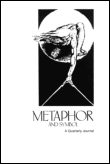
METAPHOR AND SYMBOL
Bridging Communication and Cognitive ScienceMETAPHOR AND SYMBOL is a prestigious journal dedicated to advancing the study of metaphor, symbolism, and their roles in communication and cognition. Published by Routledge Journals, Taylor & Francis Ltd, this journal possesses an impressive reputation, evidenced by its Q1 rankings in both Communication and Linguistics and Language, as well as a Q3 ranking in Experimental and Cognitive Psychology. As of 2023, it holds a notable position in Scopus rankings, standing in the 86th percentile for Social Sciences in Linguistics and Language, making it a vital resource for researchers and professionals interested in the intricate interplay between language and thought. With its convergence years extending from 2007 to 2024, METAPHOR AND SYMBOL aims to publish innovative research that explores the cognitive, communicative, and social aspects of metaphor and symbolism, thereby enriching the academic discourse in its field. While this journal is not open access, its contributions are invaluable to advancing knowledge and understanding in communication, psychology, and linguistics, ensuring it remains an essential read for scholars and students alike.
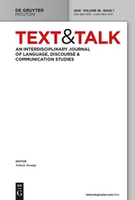
Text & Talk
Elevating Interdisciplinary Scholarship in CommunicationText & Talk, published by DE GRUYTER MOUTON, is a premier academic journal that serves as a pivotal platform for interdisciplinary scholarship in the fields of Communication, Linguistics, and Philosophy. With its ISSN 1860-7330 and E-ISSN 1860-7349, this Germany-based journal has established a robust presence since its inception in 2005, continuing through 2024. Currently ranked in the Q1 category for both Linguistics and Philosophy, and Q2 in Communication, Text & Talk demonstrates a significant impact within the scholarly community, as reflected in its impressive Scopus rankings across various disciplines. The focus of the journal is to foster rigorous discussions and innovative research on the multifaceted nature of spoken and written discourse, making it indispensable for researchers, professionals, and students eager to explore the interplay between language, context, and communication practices. As an open access title, it enhances visibility and accessibility to cutting-edge research, further solidifying its role as a vital resource in the academic landscape.

Journal of Argumentation in Context
Advancing interdisciplinary insights in argumentation dynamics.The Journal of Argumentation in Context, published by John Benjamins Publishing Co, is a leading interdisciplinary journal that explores the dynamics of argumentation across various contexts, integrating insights from the fields of communication, linguistics, and social sciences. With an ISSN of 2211-4742 and an E-ISSN of 2211-4750, the journal serves as a crucial platform for researchers and practitioners aiming to deepen their understanding of argumentative practices in both verbal and non-verbal communication. The journal, which has an impressive ranking with a Q2 quartile in Linguistics and Language and a Q3 in Communication, reflects its high impact within the academic community, evidenced by its Scopus rankings placing it in the top 20% of its fields. Although access options remain limited, the journal’s objective is clear: to foster dialogues that bridge theory and practice, and to contribute meaningfully to the ongoing conversation about argumentation strategies in diverse contexts. As the journal converges its focus from 2015 to 2024, it is poised to remain an invaluable resource for scholars, professionals, and students dedicated to advancing the study of argumentation.

Functions of Language
Fostering Scholarly Dialogue in Linguistic FunctionsFunctions of Language, published by John Benjamins Publishing Co, serves as a vital platform for scholars and practitioners in the fields of linguistics and language studies. With its ISSN 0929-998X and E-ISSN 1569-9765, this esteemed journal, based in the Netherlands, has solidified its reputation through a focused dedication to exploring the multifaceted roles that language plays across various contexts. Ranked in the top percentile of leading journals in Linguistics and Language (Q2 category, 2023) and holding impressive Scopus ranks within both the Arts and Humanities and Social Sciences sectors, the journal emphasizes research that interlinks theoretical insights with practical implications. Functions of Language aims to advance our understanding of linguistic structures and their applications, making it an essential resource for researchers, professionals, and students alike who are eager to contribute to the evolving discourse in language studies. With content converging from 1994 to 2024, the journal reflects ongoing scholarly engagement and innovation in the field.
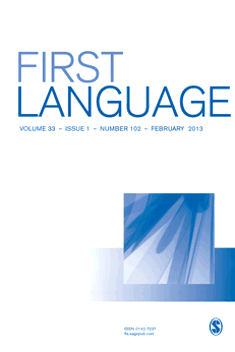
First Language
Elevating Research in Language AcquisitionFirst Language is a prestigious journal dedicated to the study of language acquisition, development, and use, published by SAGE Publications Ltd. With an ISSN of 0142-7237 and E-ISSN 1740-2344, this journal has been a vital resource in the fields of Education and Linguistics since its inception in 1980. It proudly holds a 2023 Q1 ranking in Linguistics and Language and a Q2 ranking in Education, underscoring its significant impact and contribution to these dynamic fields. Positioned in the 91st and 90th percentiles in Scopus rankings for Language and Linguistics and Social Sciences, respectively, First Language attracts a global readership, fostering rigorous scholarly discussion and exploration. The journal is not Open Access, ensuring that its curated content maintains a high level of academic integrity and exclusivity. With a rich historical scope extending to 2024, First Language serves as an essential platform for researchers, practitioners, and students committed to advancing our understanding of language in all its complexities.
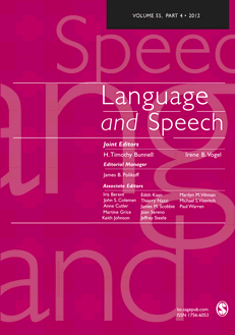
LANGUAGE AND SPEECH
Advancing the Frontiers of Communication ScienceLANGUAGE AND SPEECH, published by SAGE PUBLICATIONS LTD, is a premier journal that serves the multifaceted realms of linguistics, speech science, and sociology. With a robust history of scholarly contribution since 1958 and an anticipated continuation through to 2024, the journal is recognized for its high-impact research, boasting a commendable impact factor and achieving Q1 ranking in both Linguistics and Sociology as well as Q2 in Medicine and Speech and Hearing categories as of 2023. The journal, available in both print and online formats with ISSN 0023-8309 and E-ISSN 1756-6053, provides a vital platform for interdisciplinary discourse among researchers, professionals, and students alike. Its rigorous review process and quality publications place it at the forefront of academic inquiry, offering critical insights that advance the understanding of language and its implications in various contexts. As a key resource in the field, LANGUAGE AND SPEECH continues to foster innovation and knowledge dissemination, making it an essential addition to the libraries of those committed to exploring the depths of communication sciences.